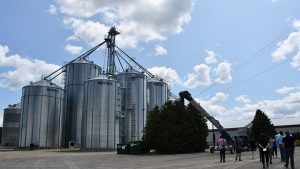Field observations
SUMMER 2020 UPDATES
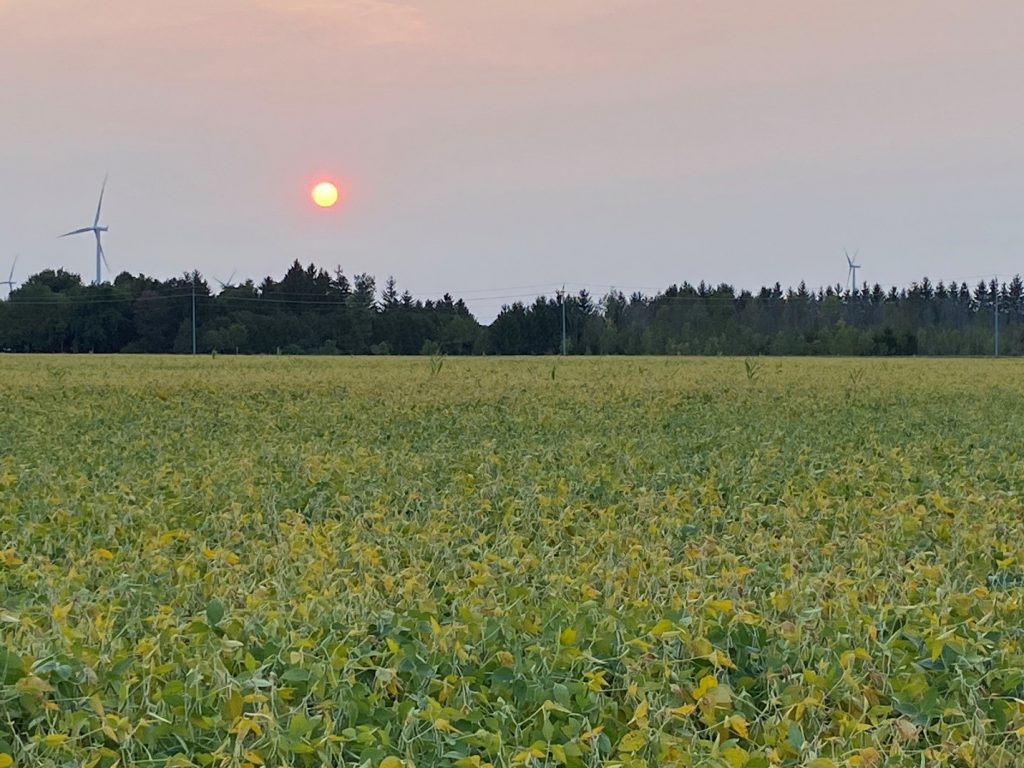
September 18, 2020
Hazy conditions covered most of southern Ontario this week. Smoke from the west coast forest fires have drifted high into the atmosphere while the jet stream’s air currents have carried the smoke particulate overhead into Ontario. Both sunrise and sunsets have been very showy as increased particulates in the atmosphere block some of the sun’s rays. The effect on agriculture is reduced solar radiation which means less sunlight energy for the plants to produce photosynthate (plant sugars). Since we are near the end of the season and soybeans are maturing rapidly this has limited effect on the more mature crops, but some late planted double cropping soybeans or full season corn may be slightly delayed, no different than when we get a prolonged overcast periods due to storm conditions. The air has already been clearing up late in the week as weather patterns and winds have changed.
A few soybean fields have been harvested this week in the earlier maturity zones to the north and east. I expect next week to be a strong week of soybean harvest with the dry forecast ahead. Cool weather this weekend will slow corn maturity as cooler weather reduces sugar production and translocation in the plant.
Frost earlier this week in the lower heat unit areas is not known to cause much damage as the soybean crop was already maturing and the corn was 50 per cent milk line or better. A few top leaves may have been damaged in the corn crop, but the rest of the canopy and stalk will help the crop finish off. After this weekend’s cool temperatures and possible light frosts, the fall forecast of slightly warmer than average temperatures and average to below average perception will give farmers an optimistic outlook for an open fall that will allow for nice harvesting conditions (dry crop, dry fields). These ideal conditions will also help with timely wheat planting in good soil conditions.
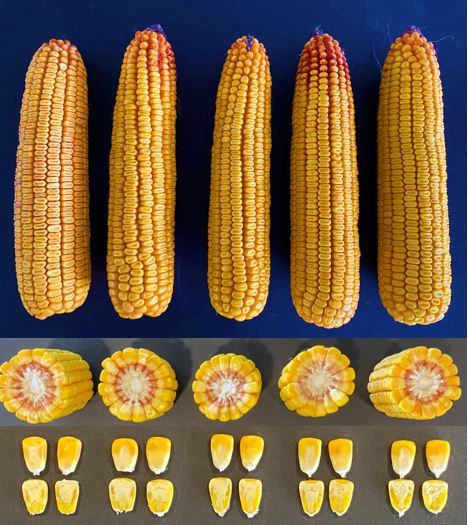
Corn
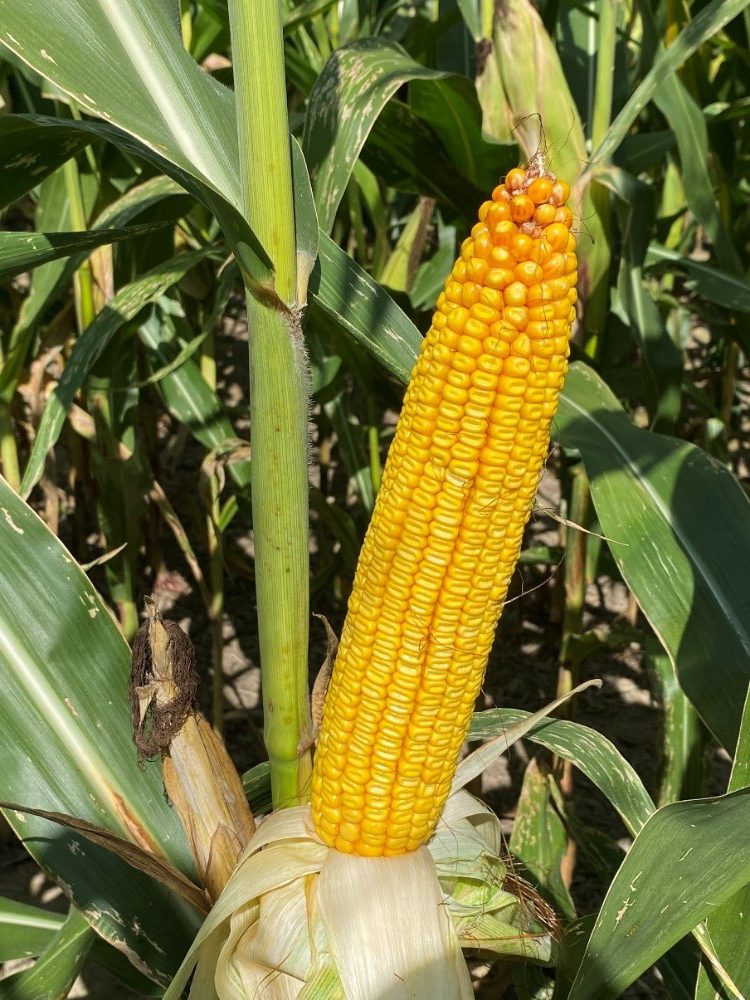
Milk line disappearance has moved another 25 per cent this week. The group of hybrids pictured are at the 80 per cent to 50 per cent% milk line. Another five to 10 days and black layer will appear as the grain approaches 32 per cent moisture. Slower than normal progress to black layer is occurring this fall as temperatures have dropped and hazy conditions from western forest fires have slowed the plants ability to assimilate sugars and finish filling the kernels. Forecasted warmer weather after the cool period this weekend will be enough to mature the corn and help grain drydown this fall. If plants die due to frost or disease at this stage, up to five per cent yield loss could be possible and only take a little test weight off the top as kernel tips will shrink. As shown in the kernel dissection, lots of starch has been formed in the top and centre of the kernel, only the kernel tip is still soft. Killing frost before true black layer (milk line at 100 per cent) that kills the entire plant causes concerns with grain dry down as grain does not have the abscissions layer to block migration of moisture in the kernel. If grain is at early dent (milk line not formed) and plant dies, yield losses could be between 15 per cent to 25 per cent depending on grain stage and severity of damage. In this situation, grain quality will be poor with immature grain and harvest and storage will be difficult. Alternative harvest options should be sought. Since most of the corn in Ontario is nearing black layer, it is not expected many fields will be in danger, but that said, you should know what your crops maturity is and if a frost event occurs you should assess the situation so you can manage any concerns well before grain harvest.
Healthy corn plants will help finish these 50 to 80 per cent milk line kernels. Really good kernel depth and hard dense starch packed into the kernel will add kernel weight to maintain maximum yield potential in this field.
For more information on frost damage implication on grain corn check out this weeks Field Crop News https://fieldcropnews.com/2020/09/omafra-field-crop-report-september-17-2020/ scroll down to the second story.
Soybeans
A few fields of soybeans have been harvested this week. With lots of mature fields across Ontario it is expected that with the favourable forecast, we will see harvest in full swing next week. Yield estimates have been above average, price rallies on the rise, and nice weather in the forecast makes farming just a little bit more enjoyable for all.
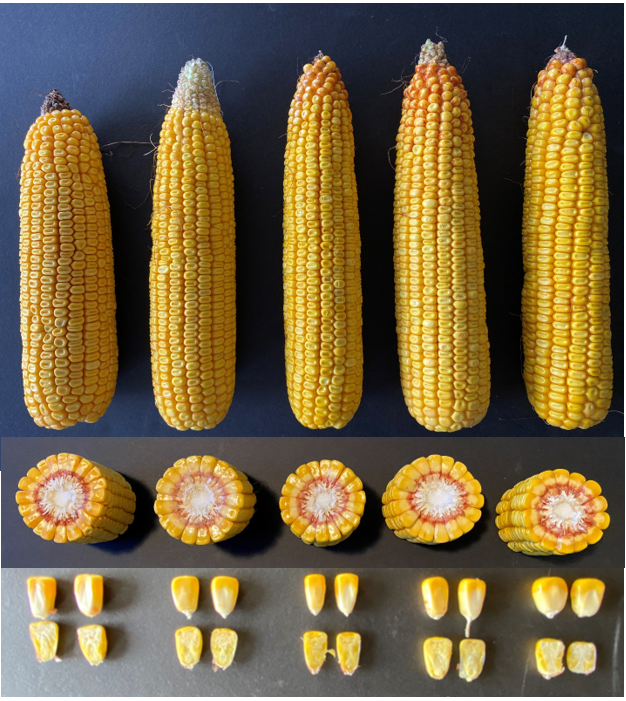
September 11, 2020
Cool and wet weather this week has blanketed the province, increasing the disease pressure on the crops still in the field. While soybeans are maturing, and the vast majority of the crop is dropping leaves, corn is still filling the kernels with starch. Lower temperatures are resulting in fewer crop heat units (CHU) accumulated per day, day length is shortening, and energy produced by the plant is reduced. Increased disease pressure is also putting pressure on starch accumulation and has the potential to hasten maturity as September progresses.
Corn
The cooler temperatures around the 20° C to 25° C has led to the development of some different disease pressures. Earlier insect feeding has created entry points for the disease spores to enter the plant. Common rust can be found, as well as eye spot and gray leaf spot. Since it is late in the season, and the majority of the corn is around half milk line, yield impact will be minor. The worst cases may show up in late planted corn with insect feeding, results may lead to quicker plant death and slightly lighter grain, but should be few and far between with limited yield impact.
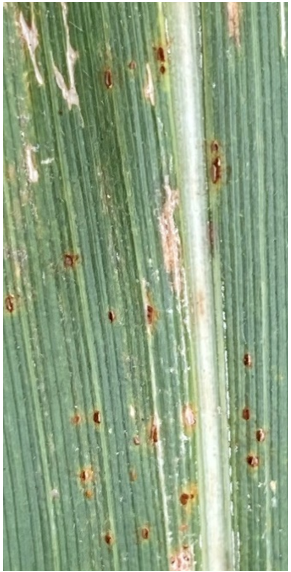
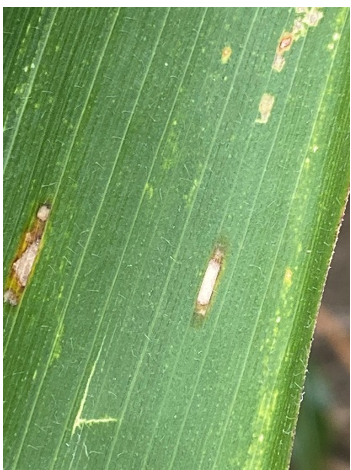
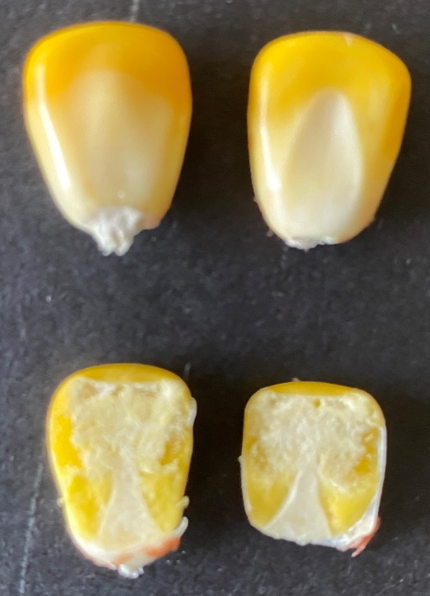
Kernel grain fill is developing well as sugars are being converted to starch. The majority of the crop is between ¼ to ¾ milk line. Over the next week to two weeks we should start to see corn at the black layer stage. At this stage, the grain is fully filled and as the abscission layer (black layer) is formed, no sugar is transported in or out of the kernel. This is when the corn plant has reached maturity and frost will not impact grain yield. The black layer can be seen by removing a kernel from the cob and peeling back the tip of the kernel.
While walking through some corn this fall, I notice several plants with purple leaves. Years ago, purple tops (top few leaves of plant were purple) indicated corn borer damage before Bt corn was introduced. The cause was insect feeding on the stalk and the leaf built up sugars giving it the purple colour. This year, we can find plants that don’t have a good ear formation (poor pollination) and the whole plant has turned purple as the leaves and plant are full of sugar with nowhere to go as kernels were not pollinated. In other cases, we may find one leaf purple as the plant has an average ear and has filled it completely, now with the remaining sugar we get an accumulation in the plant. The cause is healthy plants due to lower plant population (spring emerge issues). The agronomic correction is to get better plant stands and have warmer May temperatures.
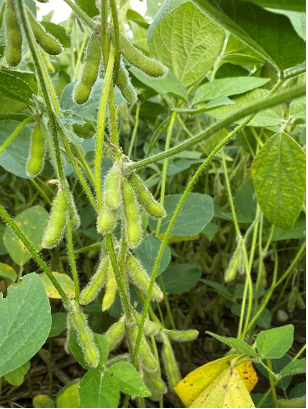
Soybeans
The crop stage of the soybean crop ranges across the province from full seed (R6) with all green pods, to many fields moving quickly into R7 (beginning maturity) where at least one pod has turned yellow and leaves are dropping quickly. Some fields in Simcoe County have been seen with 95 per cent leaf drop and pods have reached mature colour (R8). Harvest is right around the corner for a few farmers. A few more warm, dry days and soybeans will be ready in the earlier parts of the province.
Cover Crops
Updates to the “Cover Crop Decision Tool” have been made. To view the updated and refreshed tool go to http://mccc.msu.edu/covercroptool/. Thanks to the Midwest Cover Crop Council for hosting the Ontario data on the website and big thanks to all the Ontario cover crop experts that helped in the updates this summer. Refinements and updates have been made as we have incorporated the knowledge of several experienced cover crop growers and researchers. Recommendations in the tool range from which cover crop to use for your particular goals, to the best period of the year to establish a cover crop, and at what seeding rate and depth to plant at for your local area. To get the details of a species, make sure to click on the name of the cover crop.There are lots of hidden gems within this tool, make sure you add this website to your favourites list.
September 5, 2020
As September arrived in the province this week, signs of fall are showing as yellowing fields of soybeans abound. Fields are turning quickly, and signs of field problems are showing up as patchy fields of yellow and green are indicating variability. Finding the cause now helps you make decisions about how to correct the problem for upcoming years. Cover crops planted earlier in August have received nice rains to help establishment and growth, good biomass is developing to help improve soil structure for the future. Corn is gaining weight in the ear as plants are healthy and assimilating starch into the ears. Yield continues to increase as the corn crop still has a few more weeks of growing left.
Corn
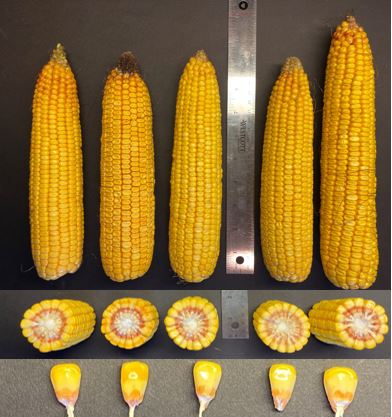
The corn crop is filling grain this week as it is in the dent (R5) stage. Some fields are starting to show brown husks which is a sign that milk line is getting around the half way mark before reaching black layer. In the photo showing five cobs, the second cob on the left is further ahead of the rest of the hybrids in a plot I visited and is at the 1/3 milk line, getting closer to half milk line while the rest of the hybrids are just at full dent and showing a ¼ milk line this week. Timely rains will help fill the kernels over the next few weeks. As the plants are still very healthy, full kernels with good tip fill and good test weight can be expected this fall.
Interesting fun fact this week: the very nice long ear actually has fewer kernels than the other ears,but has larger kernels. Yield estimates are conducted using ear count and kernels per ear, but kernel size and depth will play a role this fall in the real yield. There are still a few weeks to go before the growing season is done.
Soybeans
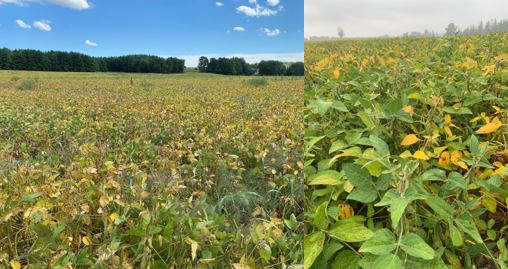
Soybeans are starting to turn colour across the province. Earlier planting dates and earlier varieties are turning yellow and are at the beginning maturity (R7) stage. Currently, uneven field maturity is an indication to farmers that not everything is uniform in the field. Low spots could be greener due to less stress due to more moisture, or it could be delayed spring emergence due to waterlogged conditions. Areas of fields that are turning yellow quicker than other areas need to be investigated, as it may be an indication of disease or insect pressure. It might be soybean cyst nematode (SCN) populations in the soil, or late season root rots. It could also be moisture deficits, but you really don’t know until you look. Scouting the crop never stops and finding out the cause of the field problem as soon as you see it is important. Trying to diagnose leaf, stem, or root issues will be difficult at harvest. Proper identification of problems will lead to better management of the field in future years.
Soybeans in the fuller maturity area of the province, mostly above 3,000 CHU, still have many green fields and the soybeans are still at the full seed (R6) stage. The varieties in this zone are longer season and the planting dates were a little later than in the earlier zones to the north and east of the province this year. Timely rains have continued to help fill the pods and size up the seed this year.
Cereals
The Ontario Cereal Crop Committee (OCCC) report was posted online as of Aug 21, 2020. The report can be found on the GoCereal website. www.gocereals.ca/performance.php
August 28, 2020
Variable weather conditions were seen across Ontario the past two weeks.. Some areas returned to dry conditions and crops showed some slight drought stress after a few weeks without rain. Other areas received timely rains and crops in these regions have shown no signs of slowing down. General rain showers earlier in the week and on Friday have given the crops a refreshing drink to help keep the plants producing sugars from the sunlight and storing it in the seed compartment of the plant.
Crop development continues at a steady pace and maturity for corn and soybeans are expected to be near normal for the eight-year average. Crop heat unit (CHU) accumulation is close to the eight-year average, while in north-central and eastern Ontario we are above the eight-year average, in the southwest we are just shy of the eight-year CHU average.
Corn
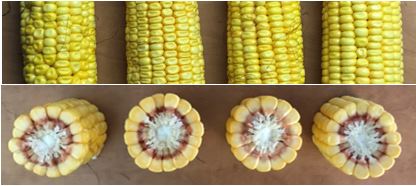
The earliest corn in one plot visited in southwestern Ontario is starting to form a visible milk line as it hits the dent stage (R5), while many other later pollinated hybrids are in the early dent stage this week. September will see rapid movement of milk line as the corn plant closes in on physiological maturity (black layer). This is the critical grain fill period for the corn crop when the plant focuses all its energy on filling the kernel. Depth and weight of kernel will be determined over the next three weeks. Maximum sunlight (solar radiation) and adequate rainfall (moisture) will provide the crop the best opportunity to fill the kernels with starch.

Milk line of the corn kernel is the line on the kernel where the hard starch meets the milky wet part of the immature kernel. This milk line will continue to progress to the tip of the kernel as the corn produces more starch and packs it into the kernel. Once the milk line has reached the tip (sugars converted to starch) then the kernel is full and the black layer (abscission layer) is formed, which restricts transfer of sugars in or out of the kernel.
Corn silage producers will be preparing their harvest equipment as silage will start in the next week to two weeks, depending on the maturity of crop and the desired moisture of the silage. Milk line is a good rough guess but the seasoned silage producer will chop some plants to find overall plant moisture in order to get the moisture right. Depending on what you are using to store the silage in (bunker vs upright silo) many producers will be targeting between 1/3 and ½ milk line, when the plants are in the 65 to 62 per cent moisture range. As the milk line progress to the tip of the kernel, the ear becomes drier and makes the entire silage sample drier. Correct moisture of silage is required to ensure correct fermentation and storage of the feed.
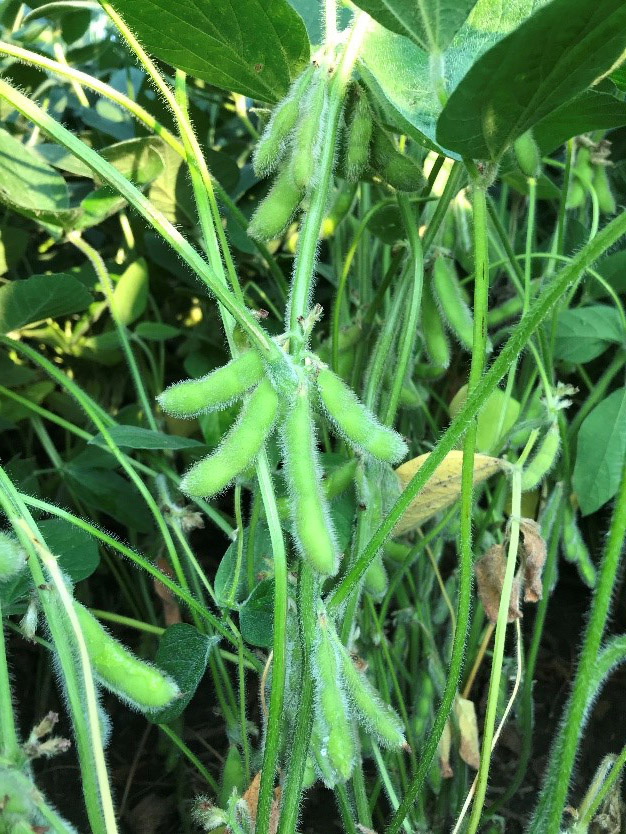
Soybeans
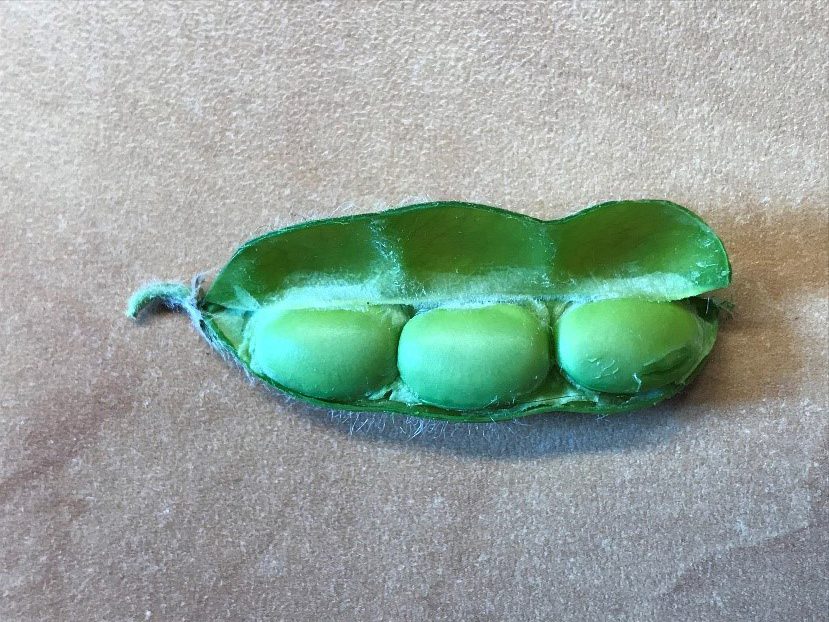
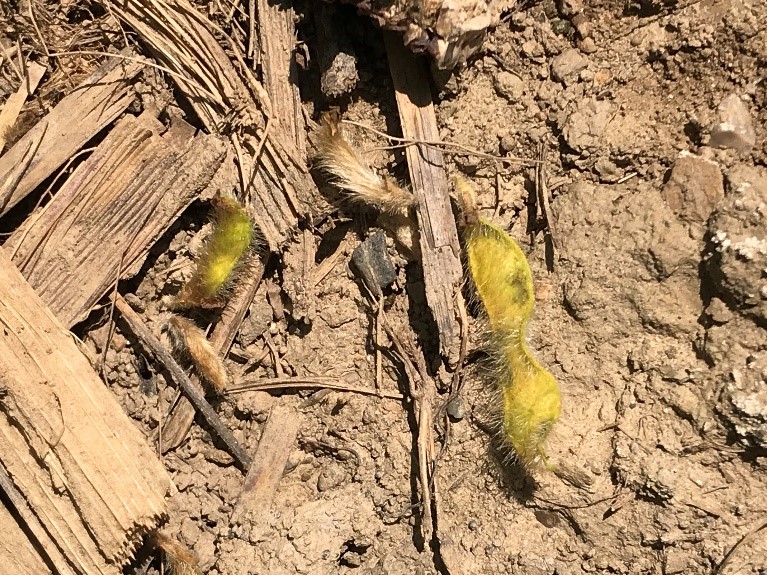
Pods continue to fill this week and have reached the R6 (Full Seed) stage of development. As dryer and hotter weather has moved in we have noticed more of the smaller pods have been dropped from the plant as the plants main goal is to fill the current pods, so excess pods will be lost during periods of stress rather than continue seed formation. Not all is lost as having limited pods and seed will mean that if rain does come in timely the plant will continue to fill the remaining seeds and seed size will be larger.
August 21, 2020
Cereals are rounding the finish line on harvest, corn is halfway through the grain development stage and soybeans are working on filling the pods. Spotty rains have dotted the province this week, giving some relief to those fields that have missed rains earlier this month. A few more rains before harvest will help put a nice finish on the crop and prevent any early plant die down.
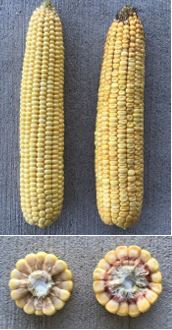
Corn
The corn crop is in the R4 (Dough) stage this week. The one ear is showing some denting as we are just a few days from the R5 (Dent) stage. No milk line showing yet so we are not officially at R5. Expect next week milk line will appear as it’s been about 30 days since pollination. In another 30 to 35 days we will be at black layer which is when the crop is physiologically mature and will be safe from any frost threat.
For corn growers that are growing corn on corn, it is a necessary practice to scout your fields, especially for corn rootworm beetle populations and root worm damage. Ideal weather the past two years have increased rootworm populations and damage to corn roots have been showing up in areas of Perth County, Huron County and the Durham Region. More details on possible insect resistance and scouting recommendations can be found in Tracy Baute’s recent article. https://fieldcropnews.com/2020/08/continuous-corn-growers-should-check-fields-for-rootworm-resistance-to-bt-hybrids/.
Soybeans
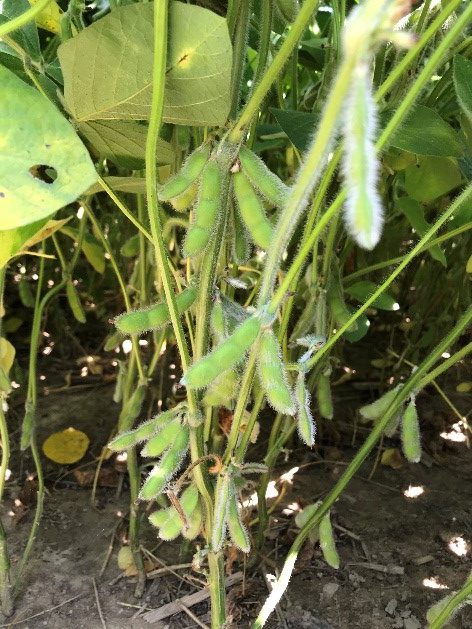
Soybean pod cluster are starting to show nicely this week. We are still in the R5 stage as the pods near the top of the plant do not have beans completely filling the pod. Flowers are hard to find as the plant reaches this maturity point and is focused on filling the pods. Sunlight and good moisture conditions over the next few weeks will help size up the soybeans and bring the yields home for us in September. Nice pod clusters with three beans pods are a sign of limited stress, the last few weeks as weekly rain showers since August 1 have been able to satisfy the moisture needs of the plant.
Cereals and Cover Crops
After the cereal crop has been harvested this year, many growers have taken the opportunity to establish cover crops to help build their soil’s health and help manage those summer weeds, thus preventing winter annuals and annual weeds from establishing. Timely rains in August have helped this cover crop get off to a good start.
It is anticipated that the Ontario Cereal Crop Committee wheat performance trials will be available soon within the next few days. When the trials are available they will be posted at https://www.gocereals.ca/performance.php
August 14, 2020
Light showers touched most of the province this week; however, drier conditions started up again in the southwest. Ground moisture has helped both the soybean and corn crops continue excellent growth in the western region. Cooler nights are signaling we are in the last half of the summer as the day length is shortening. This week we will be looking at crop maturity but also doing a yield estimate on corn and looking at disease showing up in local soybean fields due to the recent rains.
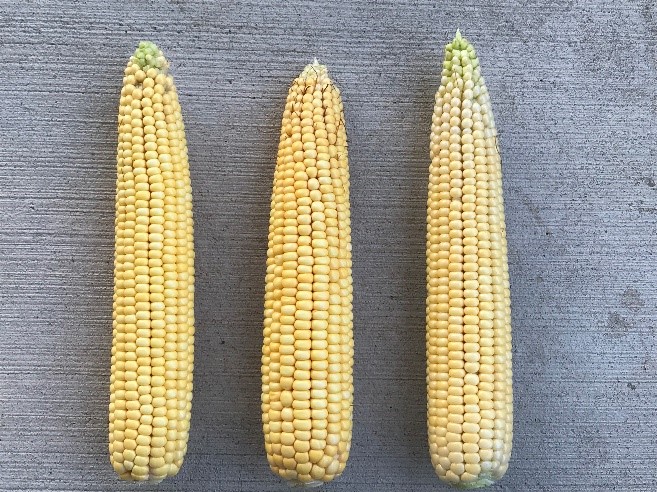
Corn
The corn crop is moving from milk (R3) to dough (R4) stage this week. The field pictured above has five different hybrids. From this field three ears were picked, each from a different hybrid. Coincidently, they all have the same number of kernel rows (16) and the same number of kernel length (45). They look different when selected, the centre cob was girthier and stuck out further (longer shank) and has a larger cob core. Kernels will most likely be bigger, but over the next month, kernel depth is what will make the difference between these hybrids. They are currently tying for yield potential, but finial yield will be dependent on the next 40 days.
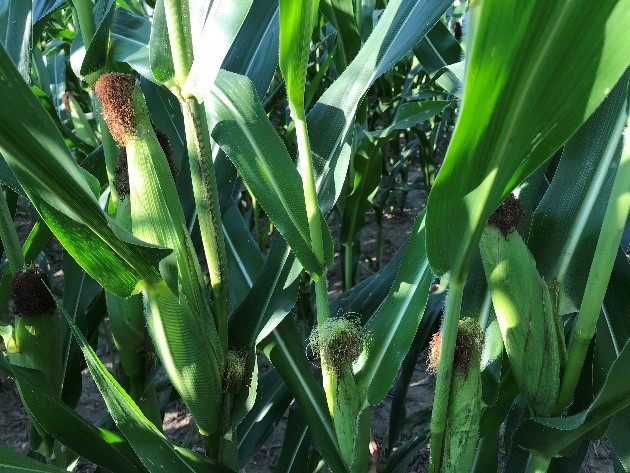
When walking fields, it’s easy to see the biggest ear first, but when doing a true evaluation, you should also look at the uniformity of the ears, and when looking at this field there are many delayed ears. The cause was uneven emergence due to the cold spring with May 6 corn planting. Cold and then wet soils created compacted soils that made the seedling emergence variable and is evident today in the field. These delayed plants will have smaller cobs, less grain and will be wetter as it is later. When doing yield evaluations, take this into account. Yield estimate is number of full ears per 1/1,000 of an acre times number of kernels on an average ear (kernel rows x kernels per row) divide by how many kernels in a bushel (1/1000). Usually 90,000 or 95,000 kernels per bushel is a good number to use, depends on if you have smaller shallower kernels (environmental) or expect larger kernels due to genetics. Use the factor 90 or 95 depending on kernel size usually works nice in Ontario.
So in this field, the calculation would be 23 ears x 720 kernels/ear divide by factor of 90 works out to 184 bu/ac. Remember, it’s just an estimate and depends on the numbers you use, don’t look for the best, look for what is really there and work with the average of several counts.
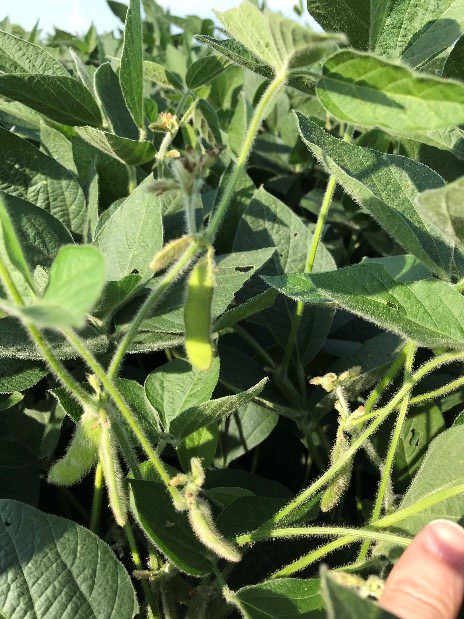
Soybean
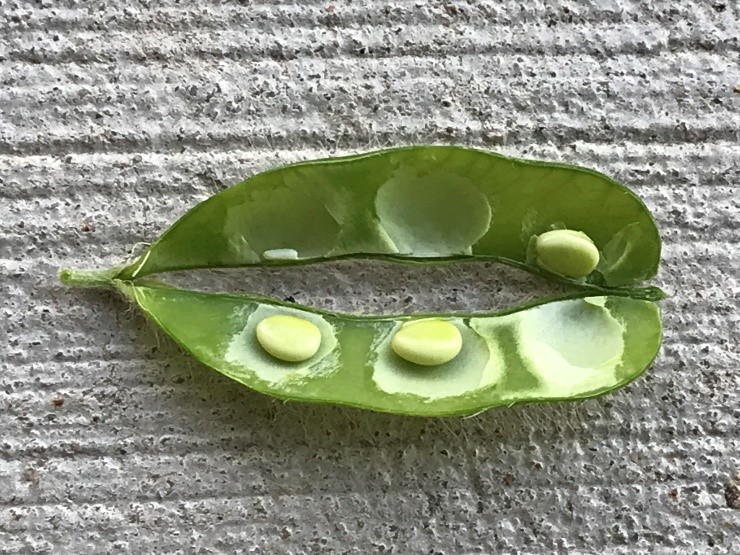
Soybeans are in the R5 (beginning seed) stage this week. Excellent canopy growth continues, and more pods have formed on the upper part of the canopy. Flowers are petering out and the remaining pods will continue to set seed over the next weeks. It is hard to get a yield estimate yet as pods are still forming and any stress the next week could abort seed. We will look at yield estimates in a few more weeks.
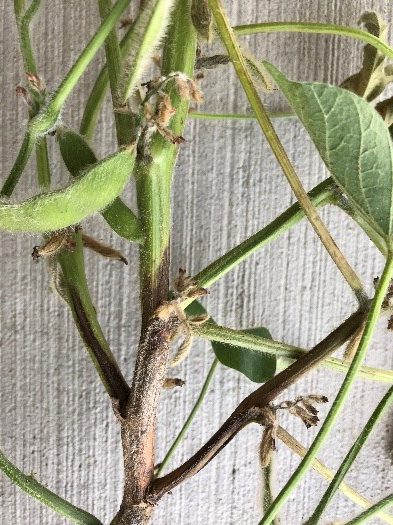

Some dead plants are showing up in the fields, make sure you look close and identify the cause. In the case of this clay field that just received lots of moisture two weeks ago, there is a stem legion that occurs from the soil line up to the 3rd or 4th node. The leaves have dried up and are still attached. These keys help identify the disease of the dead plants as Phytophthora rot. Knowing the correct cause of the problem will lead to better decisions in the future, such as rotation and variety selection.
Cereal
The preliminary winter wheat trials for Area 1 are available on the gocereals.ca website
https://www.gocereals.ca/performance.php, just click on the “Area 1 (Preliminary 2020 table)”. Due to later maturity and harvest dates of the other areas, the remaining tables are currently being worked on and will be posted in the near future.
August 7, 2020
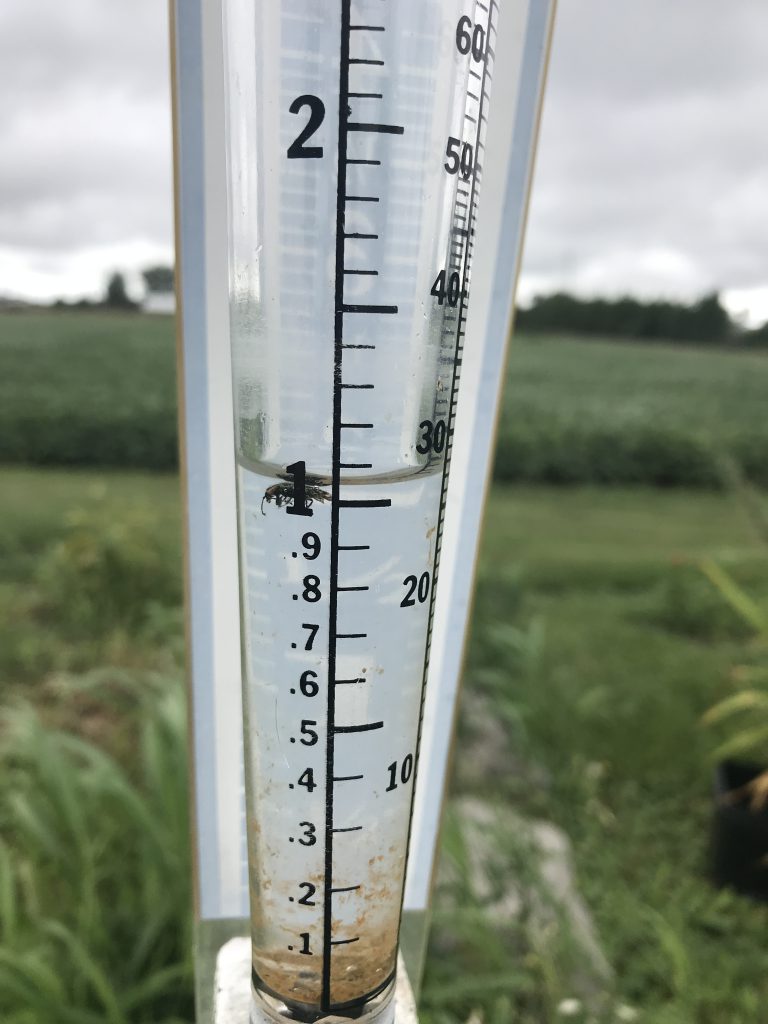
This past weekend in Ontario may not have been great for those that wanted to spend the day at the beach. But the crops received another opportunity to replenish the ground moisture required to take this crop through August. Unheard of for August, we received three inches of rain in the first three days of the month. Some areas have received excessive amounts of rain while others just received a good inch to keep the crop growing. My local area in the southwest has received seven inches in two weeks, which is unheard of this time of year. The grass has greened up and grass cutting is underway again. Usually we can take the month of August off as rain is usually scarce, but then again this is no normal year.
Some areas have received excessive amounts of rain while others just received a good inch to keep the crop growing. My local area in the southwest has received seven inches in two weeks, which is unheard of this time of year. The grass has greened up and grass cutting is underway again. Usually we can take the month of August off as rain is usually scarce, but then again this is no normal year.
Corn
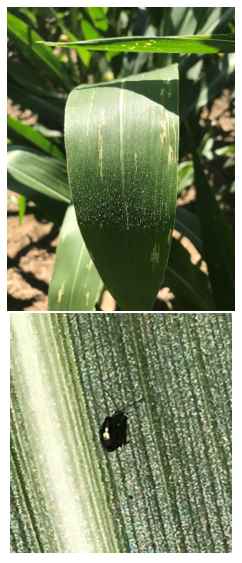
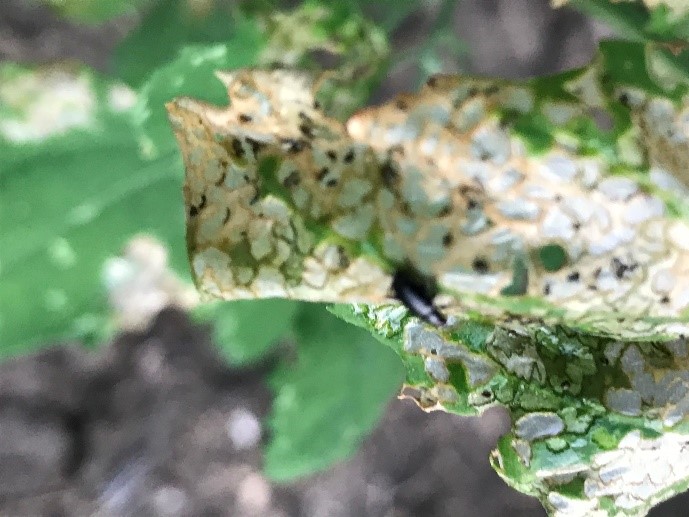
There were some interesting discoveries in the corn crop this week. With the dry weather prior to pollination, no disease has been present but after seven inches of rain through the pollination period we will start to expect some disease pressure to occur. At first look, the brown markings on the corn leaves may indicate disease, but after a quick study and the discovery of a few insects in the field, it is evident that we have an outbreak of corn flea beetle that has fed on the corn crop. The giveaway was the heavy feeding on lambsquarter plants last week
Rarely does corn flea beetle impact yield at this stage, but knowing now what the cause is will help us better manage the field for next year. If we have a mild winter the insects will overwinter and we can expect a large adult population next spring. Farmers should avoid planting corn that is susceptible to Stewarts wilt, such as susceptible inbreds or hybrids, as well sweet corn and popcorn. As flea beetle is a known carrier of Stewart’s wilt, flea beetle feeding in the spring will severely stunt or kill susceptible corn seedlings
More information is available here
- https://extension.entm.purdue.edu/fieldcropsipm/insects/corn-flea-beetle.php
- http://www.omafra.gov.on.ca/IPM/english/sweet-corn/insects/corn-flea-beetle.html
With the additional rainfall after pollination the corn plant has been able to nicely blister (R2) out the kernels and is in the early milk (R3) stage as it is just starting to show some yellow colouration on the kernels. Much of the province’s corn crop is currently in the R2 (blister) to R3 (milk) stage.
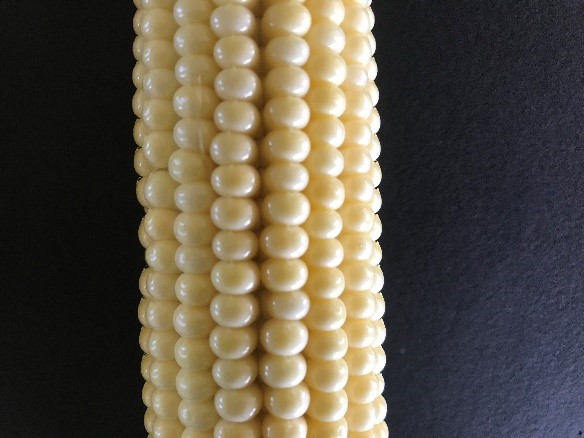
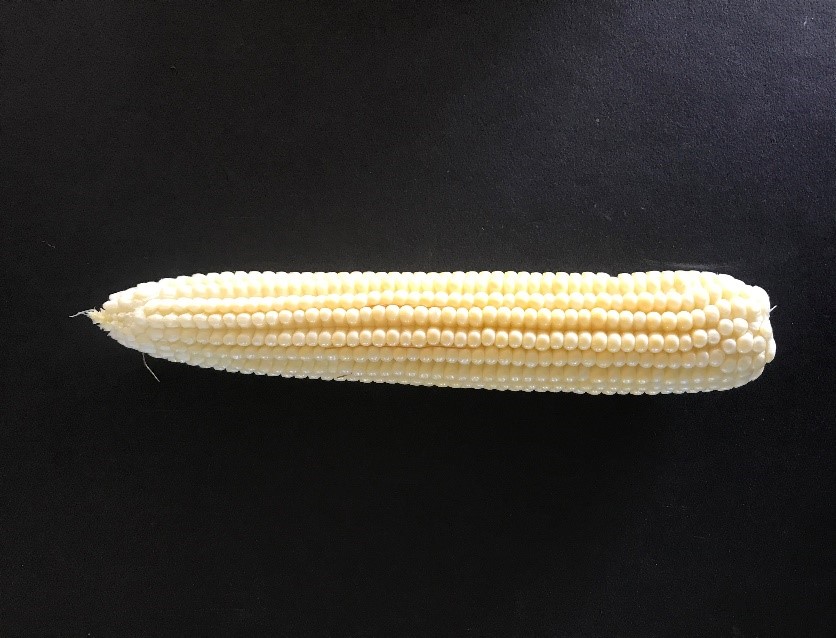
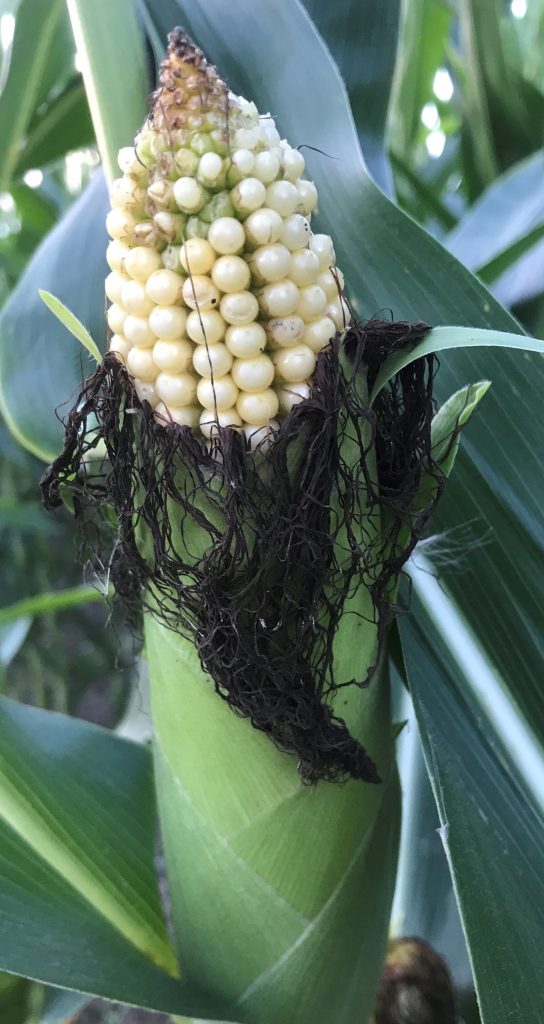
Looking closely at the corn plant we can see the drought stress on the plants that occurred earlier this year as the plant stature is shorter and the bottom internodes are abnormally short on the lower half of the plant with larger internodes above the cob. This would indicate stress at the V5 to V8 stage, and better growing conditions afterwards. Ear husks are short on many plants in the droughted areas of this field we scouted (pictured), and we found many ears that had exposed tips. Drought conditions shorten the husk development, and later rains allow for ear length to extend longer than normal. Ear length is determined around V12 and later.The drought has helped the plant build better stalk strength with shorter stalks, but the exposed tips are not good as insects and birds will clean these tips right up, limiting what we thought was going to be great big long ears.
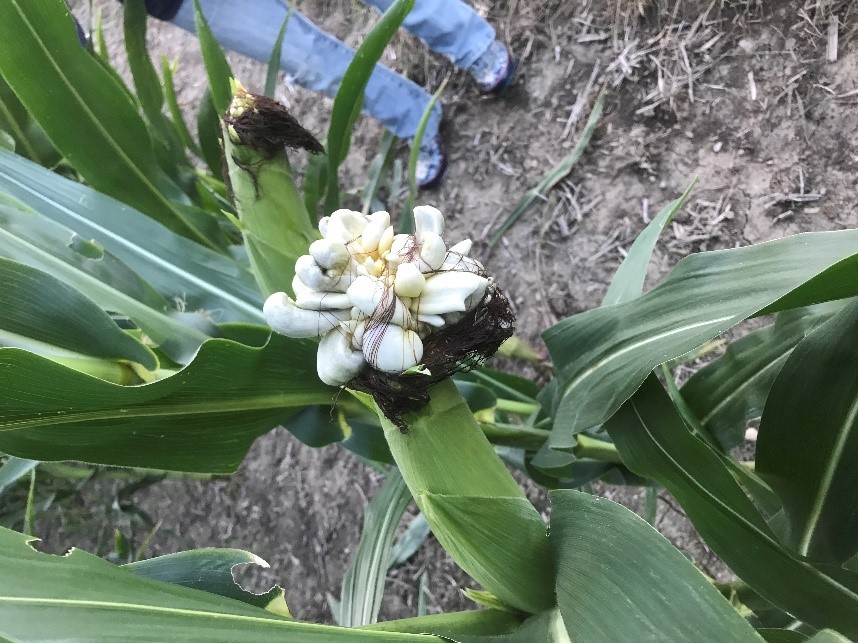
If you like the Mexican truffle (huitlacoche), then you are in luck. Now is a great time to find this on the corn plants as the fungus has had ideal (rainy) conditions as well as exposed ear tips to grow on. Huitlacoche is used in many Mexican dishes such as soups, sauces, and enchiladas. This delicacy is of course what farmers refer to as corn smut, but it is a fungus just like mushrooms, only this one is grown on corn not in manure. So, fungus from manure or fungus from corn? If you like mushrooms, try some huitlacoche as its also healthy with higher levels of protein, lysine, and essential amino acids than normal corn kernels. The best huitlacoche comes from the ear, not the corn stem, and should be picked when it is light gray in colour on the outside and has a spongy texture. Firm samples are over ripe and bitter. If you use mushrooms in a sauce, substitute sautéed huitlacoche. The taste can be described as earthy, woody, smoky, sweet, pungent, savory, and like sweet corn mixed with really good mushrooms.

Soybeans
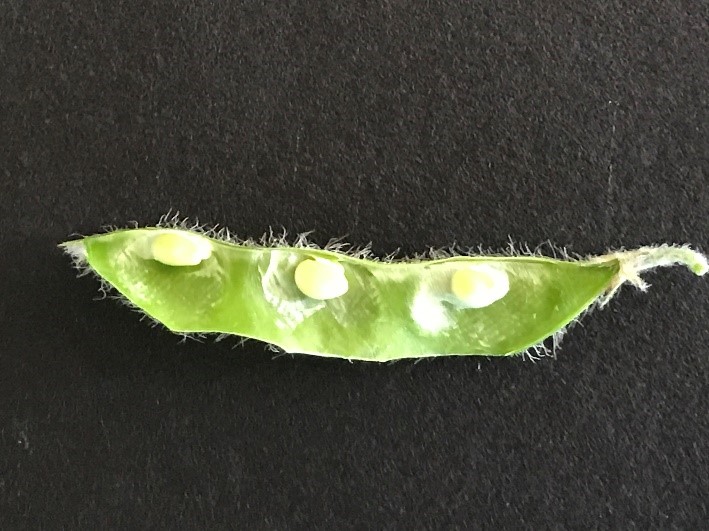
The soybean crop is in the full pod (R4) to beginning seed (R5) stage this week. The development of the crop is interesting this year as the earlier dry weather created the base of a short stocky plant as cell size is smaller with thicker cell walls under dry conditions. Over the past two weeks, withmore than adequate rainfall, the plants have been elongating rapidly as new cells are formed and are larger (pictured). Short internodes on the first five internodes and then increasingly getting longer internodes as you go up the canopy, all due to the environmental conditions at the particular growth stage. Also note smaller pods and less seeds per pod in the lower part of the plant caused by stress. A lankier top will mean some top leaning and more wavy fields this fall, but not full lodging as the base is strong and standing. Soils that had earlier moisture may see lodging, as earlier development may have seen longer internodes lower on the stem. The good news for soybean farmers is – as more flowers are being developed on the plant, full yield potential has not been realized yet. With adequate soil moisture this month, seed sizing should be good.
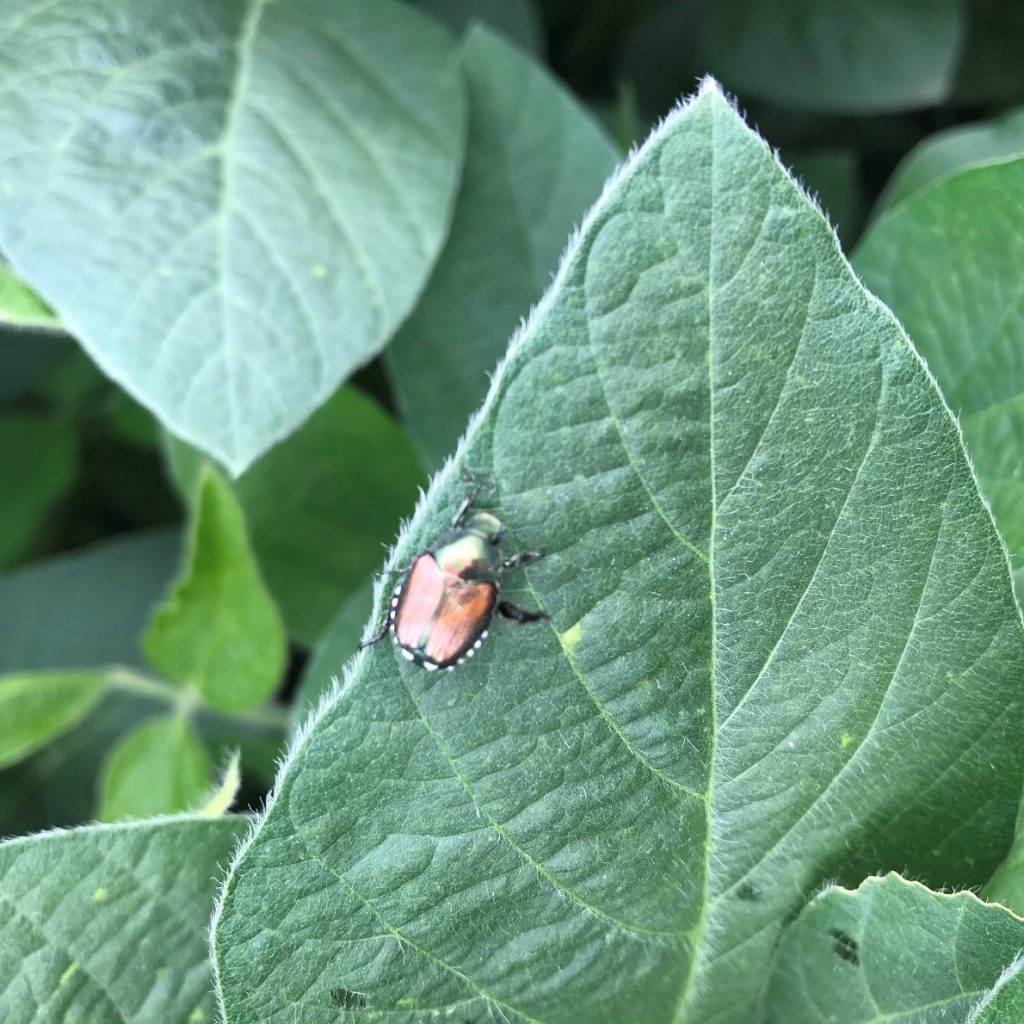
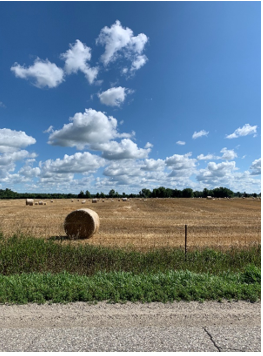
Insects, such as Japanese beetle and grass hoppers, are being found quite regularly in soybean fields. Their damage is limited, but population growth and crop damage need to be watched for escalation.
Cereals
The majority of the wheat crop has been harvested in the province with yields ranging from 40 to 120 bu/ac with some beyond this range as well. In the end, we expect the provincial average to be near normal with a million acres of production. Quality reports have shown excellent quality for the Ontario wheat harvest this year.
July 31, 2020
Much of the province experienced variable weather again this week. Some of us have watched storms go north of us and then jump south and miss us in between. While some fields have been very fortunate with adequate moisture, others have been running on low soil moisture for a while. This has led to variable field conditions from farm to farm. This will put everyone on their toes for scouting as general recommendations and applications can’t be made unless fields have been scouted. Disease and insect pressures will be different and need to be evaluated independently.
Corn

This week the corn crop has been pollinating across the countryside. If you are near a corn field, you will be able to catch the smell of pollination in the air. It is a distinctive mild odour, but a good smell to those expecting great pollination. While most of the corn crop is in the R1 (silk) stage, we are getting to the R2 (blister) stage with the earlier planted crop. An ear shake test reveals 99% pollination on this ear in southwestern Ontario (see images). Once dry silks appear at the tip end as brown silk, a quick husk back and a shake can reveal the potential kernel count of 16X50. Potential is good, but drought stress, nutrient loss, disease, and insect feeding can still take the ear back and kernels can be lost.

Western bean cutworm (WBC) counts continue to rise this week. Tracey Baute, field crop entomologist with the Ontario Ministry of Agriculture, Food and Rural Affairs (OMAFRA), is tracking WBC counts reported in Ontario. You can find her update at https://fieldcropnews.com/2020/07/western-bean-cutworm-catches-are-climbing/
Soybean
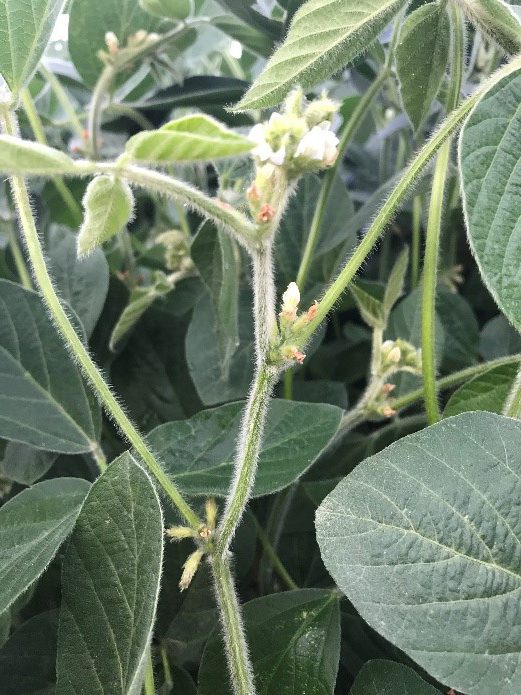
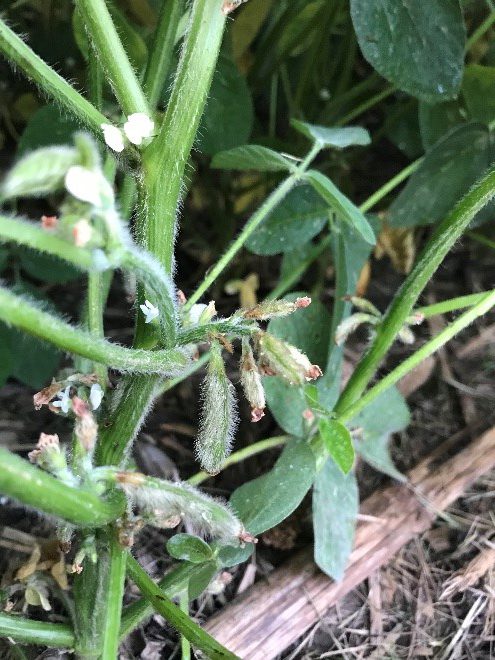
As pods are forming at the top four nodes of the plant, soybeans are considered in the beginning pod stage (R3) this week. The window for white mould control is closing for many fields as flowering is coming to an end for most of the plant. Just new top growth of the plant will continue to produce flowers as soybeans here in Ontario are indeterminant and will continue to flower on the top as new nodes form and pods develop in the canopy below.
Good pod clusters are forming where drought stress has not yet aborted flowers or pods.
Cereals
The winter wheat crop continued to be harvested across the province this week. While farmers in the southwest have wrapped up their wheat harvest, the maturity spread on wheat across the province means the harvest is in full swing in the eastern and midwestern parts of the province. Where cereal harvest has finished, manure application has started as well as seeding down of cover crops to help build the soil for next year’s crop production.
For great information on cover crop recommendations, the Midwest Cover Crop Council has a Cover Crop Decision Tool that has Ontario recommendations built into it. The tool was partly funded by Grain Farmers of Ontario. http://mccc.msu.edu/covercroptool/covercroptool.php.
July 24, 2020
This past week brought in some unsettled weather and variable storm activity across the province. Tornadoes were confirmed in Beachville, Gads Hill, Blyth, Lambton Shores, Lucan, and Belmont. In other areas, crops and buildings were damaged by winds reaching up to 150 km/hr. Dry conditions persist in parts of the province creating stress on all the crops. Some areas have received abundant rainfall to help recharge the soil moisture and allow for continued excellent crop growth; however, other areas have crops just hanging on waiting for the next rain.
Corn

The corn crop across the province is getting into the silking stage of development (R1). Silk elongation can be one to two inches per day initially and slow down as the silk gets longer and is influenced by available moisture and other stressors on the plant. The silks will continue to elongate until pollen grains have fertilized the ovule at the other end of the silk channel in the cob. To check pollination success, remove an ear of corn from the stalk and carefully remove the husk, leaving the silks intact on the cob. Gently shake the cob holding the butt end. The silks that fall off indicate fertilization success. Silks still attached and green are still viable and are waiting for pollen to fertilize the ovule. If pollen flow from the tassels in the field has stopped, pollination is done and no more kernels will form.
With the variable emergence and early stress on the crop this season, we will see the earlier pollinated cobs with higher kernel counts. The pollination period is extended due to longer pollen flow in the field from the later plants, but the later plants will not pollinate 100% and will have lower kernels per cob due to competition in the field but also due to limited viable pollen in the field when the silks are viable.
Insect feeding on the silk is another problem that can occur at silking time that can limit pollination.. Silk clipping due to corn rootworm beetle and other insects can pose a risk if insect populations are high and silk is growing slowly. More information from Tracey Baute, field crop entomologist with the Ontario Ministry of Agriculture, Food and Rural Affairs, at – https://fieldcropnews.com/2020/07/silk-clippers-watch-out-for-these-three-culprits/
For those fields that have received adequate rainfall and field conditions that favour disease development, farmers will continue to scout as fungicide application may need to be applied during silking to keep leaf diseases under control and to prevent silk infection of Gibberella and Fusarium. Keeping DON in corn low starts with scouting and timing applications appropriately at silking.
Western Bean Cutworm moth flight has started to increase this week in southwestern Ontario. The monitoring map can be found at https://ontarioca11.maps.arcgis.com/apps/MapSeries/index.html?appid=df7c044f224e4345825e75d1fa561560,
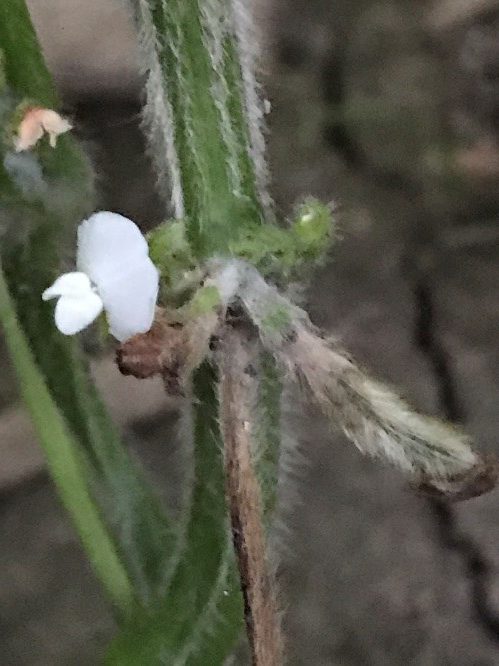
Soybeans
The soybean crop in Ontario has been growing rapidly across the province with most fields in the full flower (R2) stage.
For farmers that are concerned with white mould in fields with dense moist canopy situations, the “Sporecaster” app uses local weather forecasts and the field parameters you set and predicates the risk of white mould. Of course, variety selection and specific field management conditions will create some variability, but it is a forecast tool that you may find of interest.
Cereals
Harvest continues across the province in between the rains. The southwest is in the wrap up stage while the midwest and east is just in the beginning phases of harvest. Early reports are of good quality grain with yields in the average range for most. There is always the higher than average fields and the lower than average fields due to the variable conditions that occurred this season. The biggest impacts to yield differences this year, like many other years, was planting date, starter fertilizer, timing of nitrogen application, and rainfall (timing and amount). It will be interesting to see strip field data of sulphur applications or nitrogen rate trials to see what the impact was this year. If you have any data to share, please send it to Marty Vermey, Grain Farmers of Ontario’s senior agronomist, at mvermey@gfo.ca.
July 17, 2020
Variable rainfall last Saturday morning saw areas of the province getting a little bit of a reprieve from drought conditions. Some areas received a half inch of rain while reports of up to five inches were recorded. Unfortunately, a rapid rainfall is like drinking from a fire hose, a lot of the water ended up using surface drainage (running over the surface) rather than soaking into the ground where it’s needed for the crops.
Rain later this week continues to benefit corn and soybean crops, but has put the pause button on the wheat harvest.
Corn

Corn growth seems to have almost doubled over the week as adequate rainfall has allowed the plant to elongate quickly at this growth stage. Where rainfall has not been adequate, cell elongation will be limited, and crop height will be shorter this year.
Tassel emergence is occurring on the early planted crop and will start pollination once the silks have emerged. Some tassels may start shedding pollen, but actual pollination is when the pollen grains land on viable silks and make their way down the silk channel to the ovule at which time pollination occurs. Pollen shed from tassels can occur over several days. Pollen shedding is dependent on the environment and the genetics of the corn hybrid. Some plants will shed a little each day for three to five days while other plants (late plants) with smaller tassels may shed quickly in fewer days as they may be under more environmental stress (hotter temperatures and limited water availability, competition). While you might wish for cool, moist conditions for pollination and grain fill, those same conditions that prolong silk and pollen viability also are the ideal conditions for Gibberella ear rot (aka pink mould) and lead to DON mycotoxin production. https://cropprotectionnetwork.org/resources/articles/diseases/gibberella-ear-rot-of-corn
Many different ear disease infections can occur at silking time, as silking is the time when the ear is exposed to pathogens such as Fusarium and Gibberella. Depending on weather conditions and the spores in your field, ear disease development gets its start at the pollination stage. Infections can also occur from other ear damage from insects, animals, or hail. Which ear disease takes hold will be dependent on what spores are in your field and what weather conditions are ideal for those spores during and after infection. It’s all about timing. For the most suspectable situations farmers will be looking to protect their ears with a fungicide application at the silking time. Refer to label instructions for the best application time to help reduce infection risks.

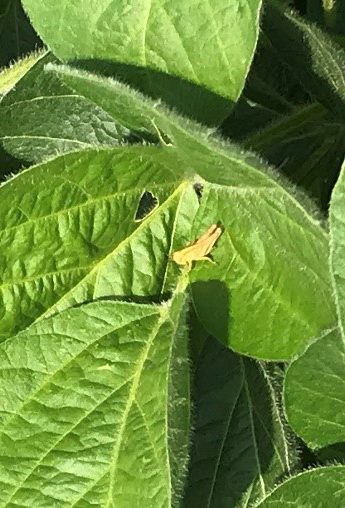
Soybeans
Rapid growth this week with adequate rainfall is helping soybean plant development. Rainfall should have been enough to wash the spider mites away for the time being. If dry conditions persist, keep an eye on field edges. https://fieldcropnews.com/2020/07/spidermites-are-thriving-in-2020-be-vigilant/
There are a lot of insects appearing, such as grasshoppers, Japanese beetle, and bean leaf beetle. In many cases the beneficial insects are working away at controlling some of the population growth of the damaging insects. Scout the fields to keep an eye on any potential damage that may occur from population explosions.
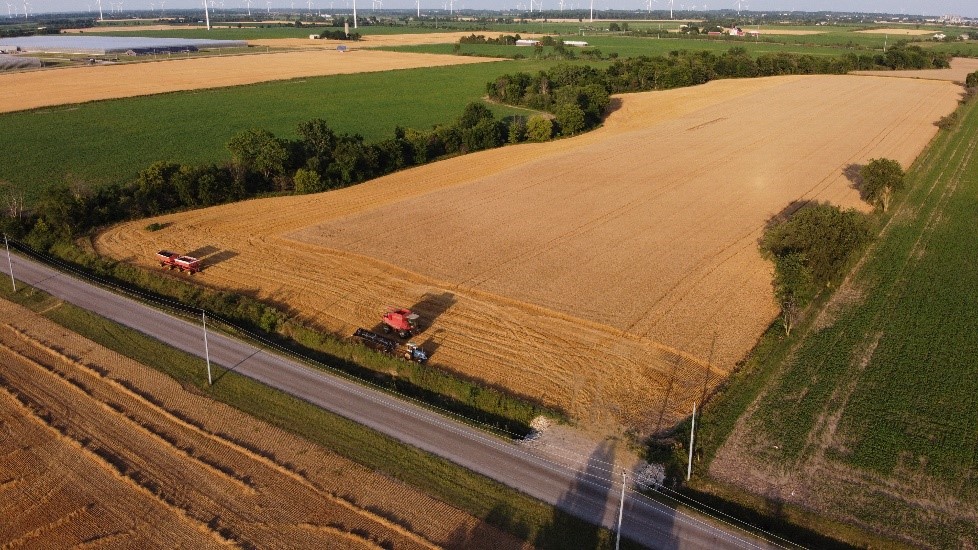
Wheat
Winter wheat harvest took a pause last weekend as rainfall came in. Harvest started back up on Tuesday. Grain moistures have increased due to the rainfall and higher humidity conditions. Harvest reports this week have indicated grain moisture in a range from 13% to 20% . Humid conditions have slowed the harvest progress.
Cereal trial data from the provincial performance trials will be made once all the research plots have been harvested and data has been analyzed. Trials are in good shape this year and we expect data to be available by the end of August.
July 10, 2020
Wheat harvest has begun in Ontario. Hot and dry weather this week has created ideal conditions for thunderstorms to develop. This isn’t good for wheat, but corn and spring cereals sure could use a rain. Soybeans are fairing well in the heat, but will need their rain in August.
Corn
There is the Good, the Bad, and the Ugly out there this year for corn fields. There are so many factors that make a good corn crop, but rain is a necessity.
The “Good” fields have received the rains and were planted early and look amazing. Tassels in some of these fields are just starting to break through and will be in full tassel next week.

The “Bad” fields that have received rain just in time look okay but are variable as they may have had issues with planting timing, weed control, and/or compaction. Typically, these are the fields planted between May 4-8 that had a cold spell until May 15 and have been struggling ever since. The plants emerged unevenly so the crop will not be uniform for the rest of the year.
Then there is the “Ugly”. Unfortunately, this crop had many things go wrong: planted wet, planted shallow, compaction from last year, missed the rains, or had weed problems taking moisture from the corn early in the season.
Given these circumstances, we need to classify our fields and manage them properly until harvest. Good fields may still have a few challenges and if you are getting rains, be sure to protect them during pollination to prevent DON production in the grain. The ”Bad” fields will be uneven, and if dry weather is the problem, moulds will not be, but if the plant starts moving nutrients around and start robbing from the stalk and bottom leaves, the issue of stalk logging could be imminent this fall. Those who have the “Ugly” should be cautious not to spend any more money, as the chance of getting any payback is limited. You might need to find an alternative market such as silage. Be sure to call Agricorp and start a claim.
Rain at pollination is going to determine how this corn crop will be able to produce for this year. Drought stress at pollination (next two weeks) will limit the ability of the crop to initiate kernel development. Fewer kernels means less bushels per acre. Corn will try to make as much grain as possible so some kernel pollination and development will occur, but it will be limited based on the resources the plants can acquire.
Insects can pose a challenge as well. We still need to watch for Western Bean Cutworm. You should have your traps up as they should be arriving shortly.
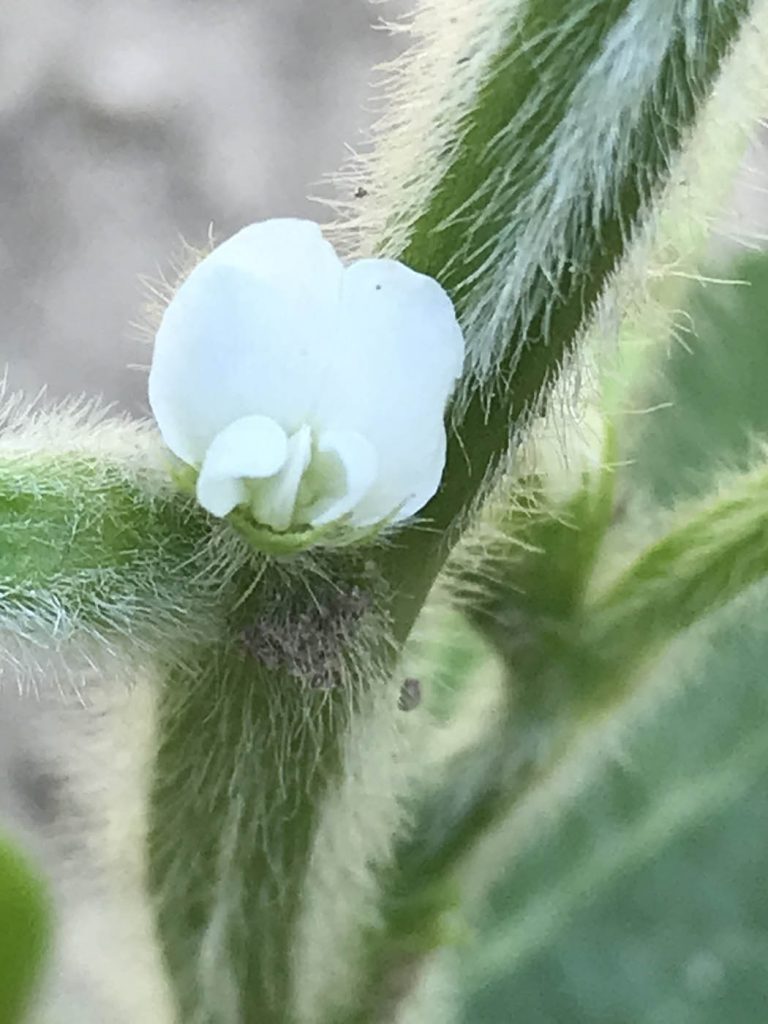
Soybeans
Soybeans are growing quickly. Now that we are past the third trifoliate, the branching and additional trifoliates develop quickly. Flowers are now forming, and most fields are at the R1 stage (first flowers on any node). In early planted fields, there may be plants at V2 (full flower – when there are flowers at the upper one or second node). Soybeans grown in Ontario are indeterminate type, they will continue to put out more flowers as the plant continues to grow developing pods on the lower part of the canopy and continue to produce flowers as the plant continues to grow. Dry weather for the beans now at flowering is okay as any loss in flowers can be made up in the next month. Dry weather during flowering limits white mould infection of the open flower. Rain for pod fill in August will be needed to make the crop.
Be on the lookout for two spotted spider mites. During periods of dry weather, spider mites will move into the edges of soybean fields. Do not mow the grass along soybean fields at this time as this will cause the spider mites to move into the field faster. Check out Tracey Baute’s article on spider mites for more identification and control recommendations. https://fieldcropnews.com/2020/07/spidermites-are-thriving-in-2020-be-vigulent/.
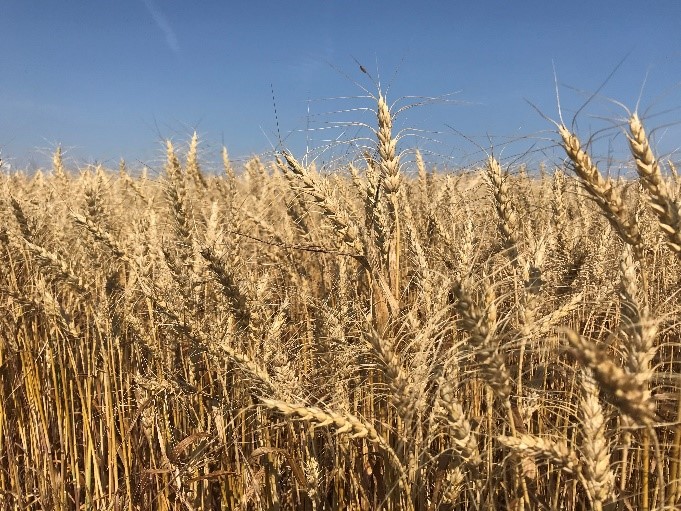
Cereal
Winter wheat harvest started in Essex County last weekend, with Kent County starting up on Monday. Hot dry temperatures dried the grain quickly. Low humidity on Tuesday morning prompted many farmers to start up at 10 a.m. Yields are okay as the plant stands were excellent on the early planted fields and tillering was exceptional this spring with the cooler weather. The only problem encountered on some of the crop was a rapid grain fill period in June. The crop flowered during the first week of June and had hot temperatures and limited rainfall during grain fill, limiting the time the crop had to put carbohydrates into the kernel, limiting grain fill. Those with limited to no rainfall in June will see the top end of their yield reduced due to smaller kernel size and aborted kernels. Grain quality to date has been excellent. Those fields that caught timely rains during grain fill will have an exceptional crop.
The Ontario Cereal Crop Committee had their western Ontario inspection tour this week. Trial locations inspected were Ripley, Palmerston, and Elora. Crops inspected were winter wheat, spring wheat, oats, and barley. Overall, trials look good this year and it looks like we will have a good dataset. Harvest for these trials are a few weeks away for the winter wheat and not until next month for the spring cereals as the spring crops have just pollinated and are just starting the grain fill stage.
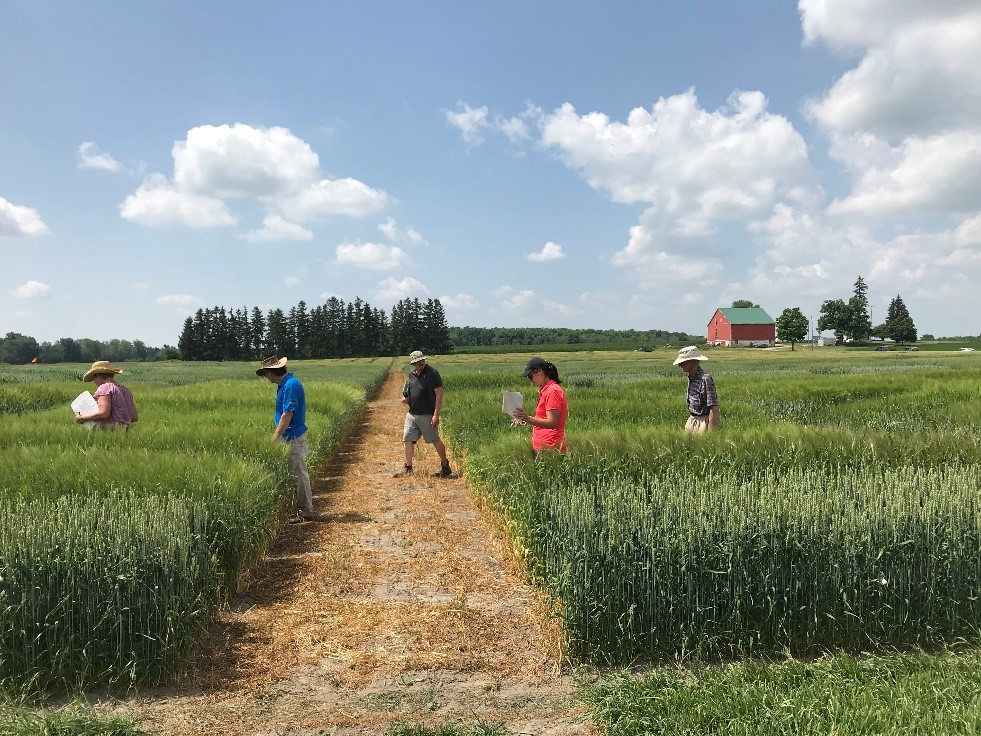
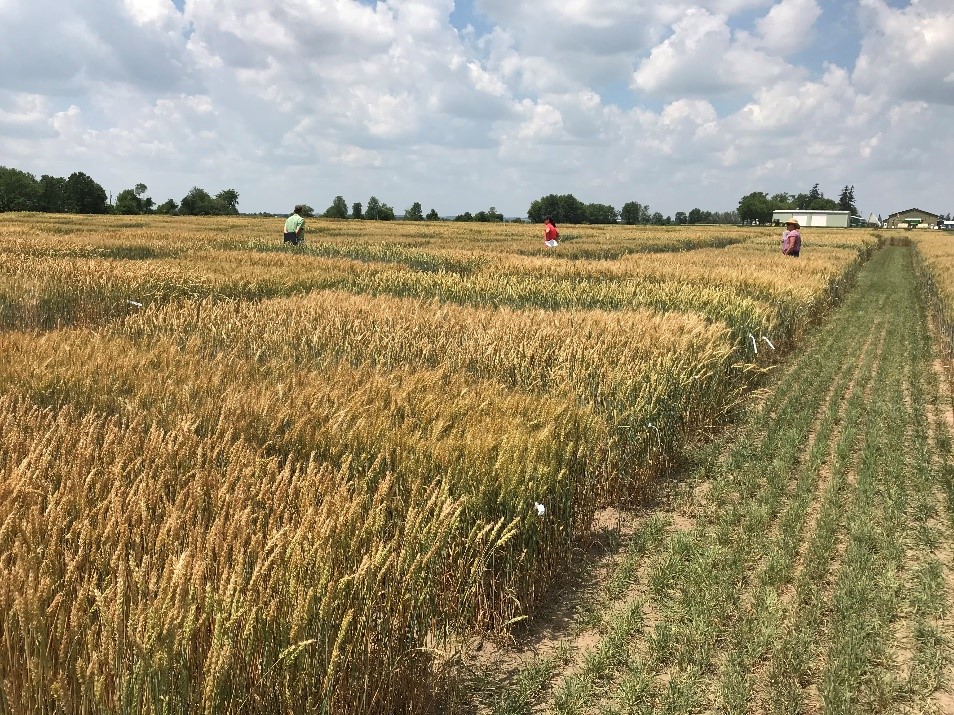
July 3, 2020
Warm temperatures are moving the winter wheat crop closer to the finish line; the crop has turned a golden colour in southwestern Ontario. Harvest will begin next week in the southern part of the province where moisture has been limited and the crop has died down.
Spotty rains have kept most of the corn and soybean crops moving along well in development. More rain will be needed in the upcoming weeks as the corn crop reaches pollination in the next 15 days.
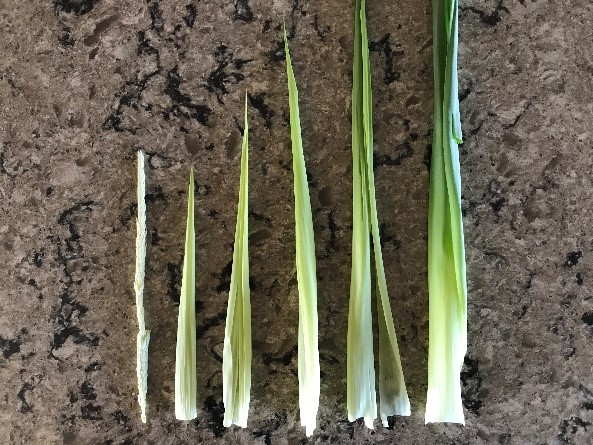
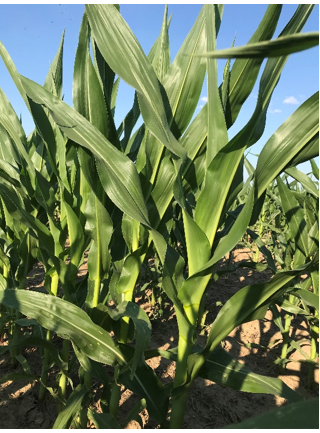
Corn
Corn at the V11 stage is chest high and has five more leaves to emerge from the whorl before the tassel emerges. During this current heatwave we will see a new leaf emerge every three to four days. We will expect to see corn tasseling the week of July 13. Due to the variability of stress on the fields this year, we will see more fields with uneven tassel and silk emergence within a field.
The timing of foliar fungicides at pollination for control of DON will be more of a challenge in these fields. By now, the number of kernel rows on the cob has been determined (V8 -V10) and the number of kernels per row is determined at this time (V10 – V12). When evaluating ear size this fall, reflect back to the growing conditions the crop was under during ear set, as environment by genetic interactions do occur
Soybeans
Albert Tenuta, field crop plant pathologist with the Ontario Ministry of Agriculture, Food and Rural Affairs, has found female soybean cyst nematodes (SCN) already developing on soybean roots. SCN are already active and will continue to feed on the soybean roots and rob the plant of nutrients. The effects of SCN will be much more pronounced as the plant will be under multiple stresses as we are dealing with heat and drought stress on the crop.
Insects to keep an eye on this summer will be soybean aphids and spider mites. The hope is that there are enough beneficial lady bugs that they will be ready to feed on the aphids. If you see a population surge on aphids, don’t spray unless you reach the threshold of over 250 insects per plant and they continue to climb above that. Spraying for aphids also removes the beneficial insects that will help to control the aphids for the rest of the year. Keep lady bugs around for as long as you can as they are doing the pest control work for you. As wheat is being harvested and dry weather persists, spider mites will be the next insect that will need to be scouted for and sprayed if the threshold of four mites per leaf is met.
The field perimeter, or areas where they move into the field, is all that needs to be sprayed.
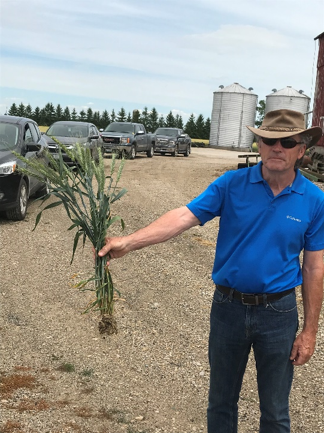
Cereals
Peter Johnson, agronomist with Real Agriculture, was looking for a wheat plant with lots of wheat heads. Pete found this plant while on the Ontario Cereal Crop Committee (OCCC) tour last week in Inwood. A single seed produced 25 wheat heads. Not bad when a plant has lots of room to grow in open space. Johnson’s next quest is to figure out how to do that with 1.4 million seeds per acre.
The OCCC wheat tour last week observed social distancing rules while inspecting the winter wheat trials from Woodslee to Centralia with stops in Tupperville and Inwood. Wheat trials look good this year and we expect to have some good data from Zone 1. Wheat tours will continue next week as the crop matures across the province.
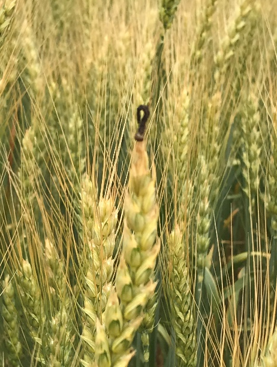
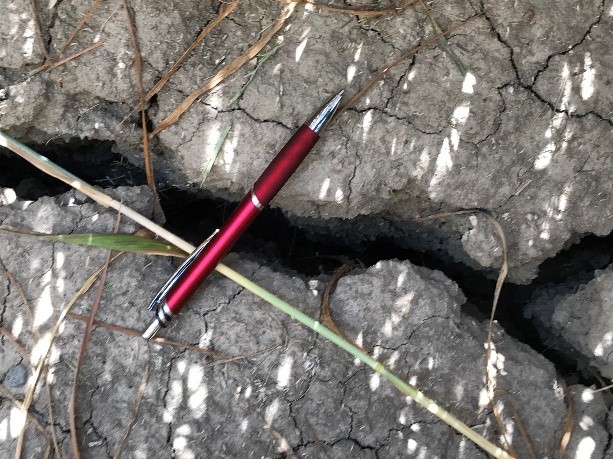
Areas that received timely rains over the past two weeks will have a tremendous wheat crop this year. Unfortunately, there are a lot of areas that missed a rain or two and do have small wheat kernels and some aborted kernels. Top ends will not be seen by all, but the quality of grain looks to be good with very few fusarium infected heads.
As harvest will be starting up in the province, we hope all farmers will have a safe and timely harvest. Please remember to protect yourselves and those you work with by practicing social distancing when delivering grain. Contact your delivery point and ask what requirements are expected this harvest season. This may affect how you bring samples in for moisture checks or how receipts are received as most locations are not allowing people in the buildings. Plan ahead, be patient, and be safe.
June 26, 2020
THE CRACKS ARE starting to show in the 2020 winter wheat crop. Literally, the cracks in the soil are expanding greater this week as the crop is removing a tremendous amount of water from the soil as its water use is greatest now that it is trying to fill the wheat heads.
Warm and dry weather has continued across the province this week, with some isolated showers gracing a few locations. Thunderstorms have brought flash rains to some locations. Large areas of the province have missed several critical showers resulting in extended stress on the crops.
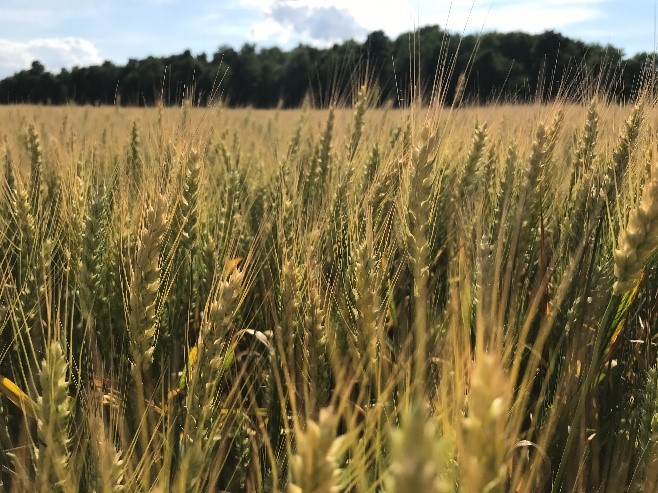
CEREALS
Dry weather has taken the top end out of the bulk of the cereal crop. Many winter wheat fields are starting to turn yellow in southern Ontario. The flag leaves are drying out as the wheat plants start to cannibalize themselves as they try to finish grain development. Fields receiving a timely rain have been able to continue to produce sugars and accumulate starch in the kernels as flag leaves are still green. Rapid senescence (death) will occur in these drier areas as harvest timing approaches rapidly.
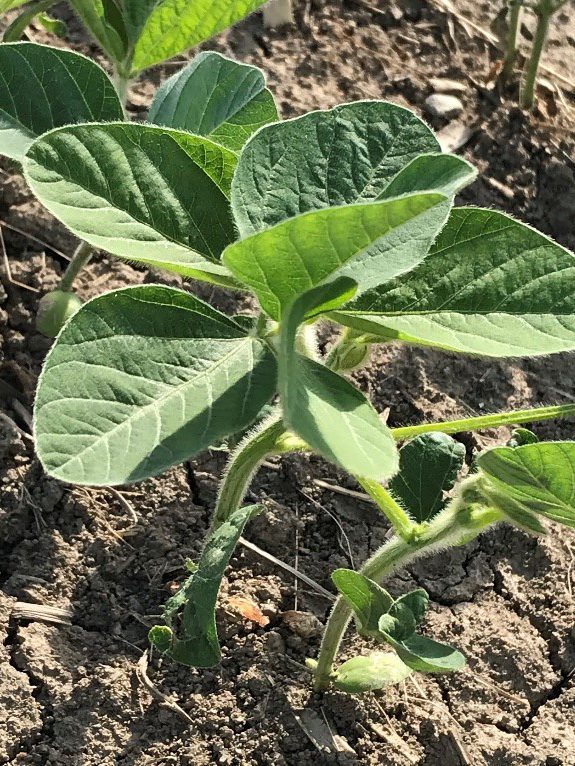
SOYBEANS
Replanting of some crusted fields continued this week as light rains did not arrive to help soften the crust. Timely rains will help plant stand establish on the later planted fields as some seed remains in dry soil. Earlier planted fields are in the 3rd – 4th trifoliate, while the majority of the crop acres are in the 2nd trifoliate stage of growth.
Post emerge herbicide applications are being applied on fields that are experiencing weed escapes.
CORN
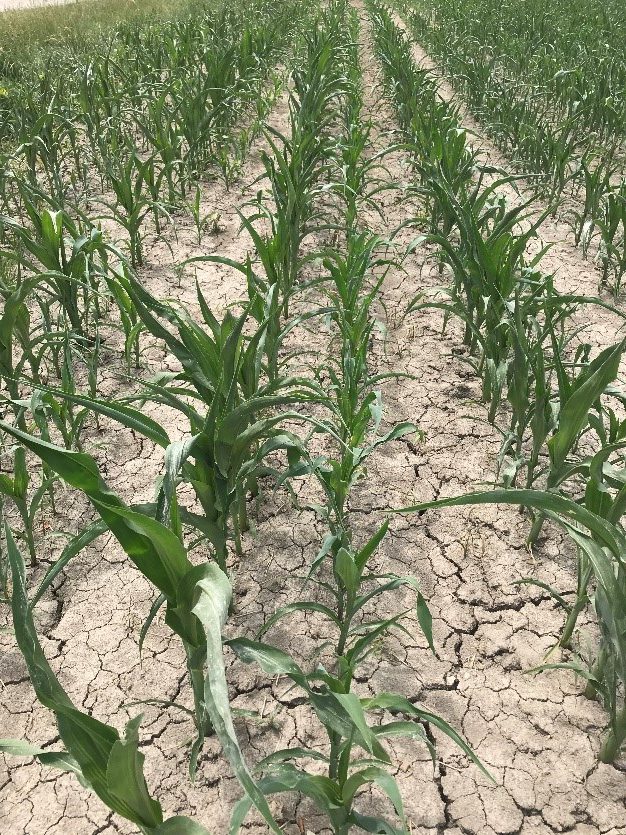
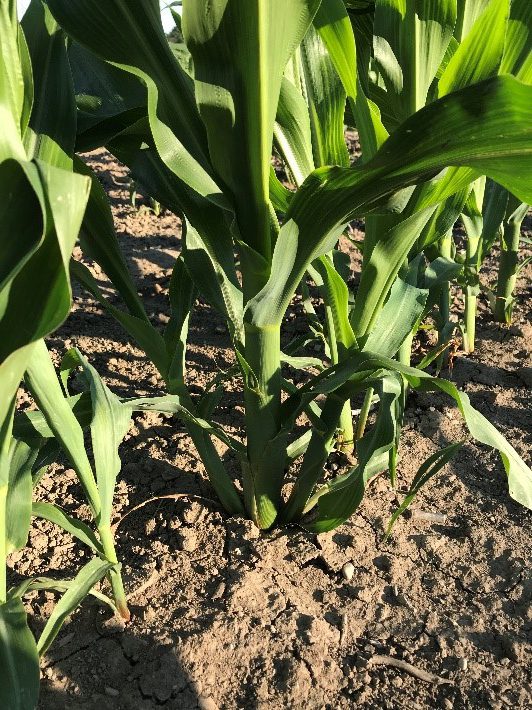
Corn has been growing quickly over the past week. Ideal heat and sunshine drives plant growth at this V8 leaf stage. Under ideal conditions it has been noticed that the early emerging plants of the field are producing multiple tillers. This is all driven by the environment and some plants will show more activity as they have ideal root development and plant growth .They were the first to emerge and have had the advantage of more sun, moisture, and nutrients and with this advantage are putting the extra growth into tillers. Fields with lower populations, but same or higher nutrients, will see more tillers if moisture conditions will allow. Even in dry fields this is evident as many fields struggled to emerge and emergence was so variable. Tillers do not take away yield, rather it’s an indication that the plant growth is ideal for that particular plant.
Corn fields that had been crusted over in May and were touched up with a second planting are seeing some stress conditions with the higher population. The two crops will compete all year. Ideally one of the crops needs to be removed.
























